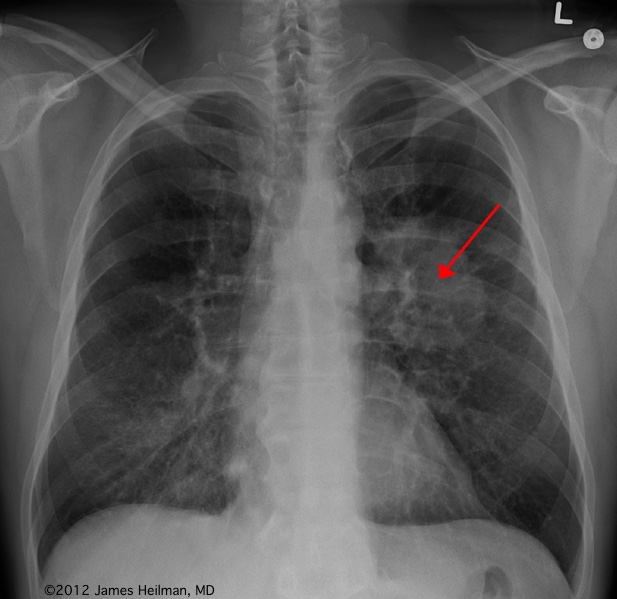Respiratory Quiz
Here are 4 questions about a 66 year-old male with a lesion on Xray. How many can you answer correctly?

A 66 year-old male comes to the physician with 5-day history of "coughing up blood". He denies smoking and has had a 20-lb weight loss over the last 2 years. A chest Xray is performed and shown above. A biopsy shows nests of cells with abundant pink cytoplasm, irregular hyperchromatic nuclei, and intercellular bridging.
Please answer the question.
Please answer the question.
Please answer the question.
Please answer the question.
/
/
/
/
/
/
Scroll down for the Answer
/
/
/
/
/
/
/
/
/
/
/
/
/
/
/
/
Q1 Answer: Radon Gas
Radon gas accounts for about 20,000 cases of lung cancer per year making it the second most common cause of lung cancer.
Radon is on odorless radioactive gas that comes from the radioactive decay of uranium in the soil. It can enter homes and buildings through the foundations and can be found in high levels in some basements. It is important to have your home check for radon levels!
The most common risk factor for lung cancer is cigarette smoking which is linked to approximately 90% of lung cancers.
Other risk factors for lung cancer are arsenic, asbestos, chromium, ionizing radiation, and outdoor air pollution.
Q2 Answer: Kidney Stone
Squamous cell carcinoma is associated with production of PTH-related peptide which leads to hypercalcemia and increased risk of kidney stones. Gynecomastia is assocatiaed with Large cell carcinoma. Eaton-Lambert, Cushing, Carcinoid, SIADH, and polycythemia are most commonly associated with small cell lung cancers.
Q3 Answer: Desmosomes
Squamous cell carcinoma typically has keratin whirls and intercellular bridging which represents desmosomes. Bombesin, Neurosecretory granules, and S100 positivity are associated with small cell carcinoma. Psammomma bodies are most commonly assocated with mesotheliomas, meningiomas, papillary thyroid, and papillary serous tumors of the ovary. Adenocarcinoma is most likely to have mucous production.
Q4 Answer: Yearly Low dose Chest CT
Annual screening for lung cancer in 30 pack-year history smokers with low dose computed tomography. See Lung Cancer Screening
Xray Photo by James Heilman, MD [CC BY-SA 3.0]